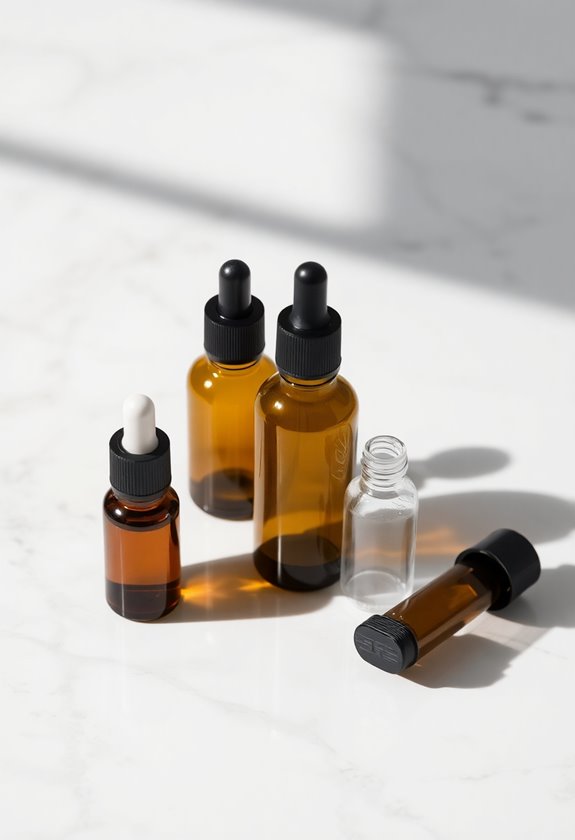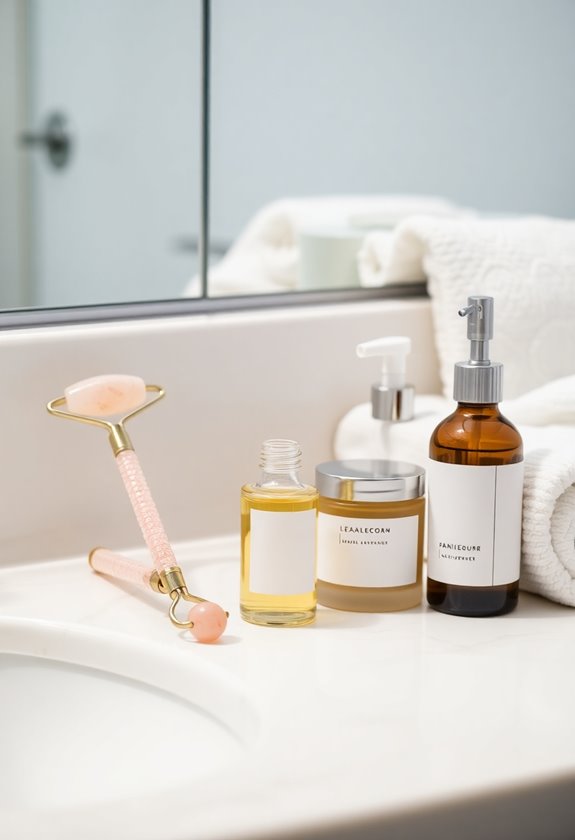To layer multiple serums effectively, start with water-based formulas and work your way to oil-based ones, following the thinnest-to-thickest rule. Apply your most active ingredients first, like vitamin C or niacinamide in the morning, or retinol at night. Wait 30-60 seconds between each layer to allow proper absorption, and avoid mixing conflicting ingredients like vitamin C with retinol. Remember to apply antioxidants before hydrating serums, and always finish with your thickest, oil-based products. Understanding these layering principles will guarantee your skin receives maximum benefits from each serum's active ingredients.
Highlights
- Start with water-based serums, followed by gel-based serums, then viscous serums, and finish with oil-based formulas.
- Wait 30-60 seconds between each serum application to ensure proper absorption into the skin.
- Apply antioxidant serums like vitamin C first in the morning, and exfoliating serums first at night.
- Avoid mixing vitamin C with retinol or niacinamide, and don't combine multiple active ingredients simultaneously.
- Use thinnest to thickest consistency as a general rule, and always finish with a moisturizer to seal everything in.
Understanding Serum Layering Basics

Skincare's most potent products deserve careful consideration when it comes to layering. You'll want to follow three essential principles when applying multiple serums to maximize their effectiveness and prevent any negative interactions.
- Start with water-based serums first, as they're lightweight and absorb quickly into clean skin
- Apply oil-based serums second, since they'll create a barrier that other products can't penetrate effectively
- Wait 30-60 seconds between each serum application to allow proper absorption
When you're layering serums, you should also consider their active ingredients and pH levels to prevent neutralization. For instance, you'll need to separate vitamin C from retinol, and niacinamide from vitamin C, applying them at different times of day for best results. Vitamin C serums are particularly beneficial for brightening skin tone and promoting collagen production.
Water Based Vs Oil Based

Understanding the difference between water-based and oil-based serums is essential for your layering routine. Water-based serums have a lightweight, gel-like consistency that penetrates quickly into your skin, while oil-based formulas create a protective barrier and take longer to absorb.
Here's how to identify and apply these serums properly:
- Water-based serums appear clear or translucent and feel lightweight on your fingertips
- Oil-based serums have a thicker, more viscous texture and often appear cloudy or opaque
- Always apply water-based serums first, as they won't penetrate through oil-based products
- Wait 30-60 seconds between applying different serums to allow proper absorption
You'll want to layer your serums from thinnest to thickest consistency, which naturally aligns with the water-before-oil rule that's fundamental to effective skincare routines.
For enhanced results, consider incorporating facial oils into your routine as the final step to seal in all the beneficial ingredients.
The Thinnest to Thickest Rule

Following the water-before-oil principle, the thinnest-to-thickest rule helps you maximize the effectiveness of your skincare products. When you layer your serums from thinnest to thickest consistency, you're allowing each product to penetrate the skin properly without creating barriers.
Here's how to determine the correct order:
- Start with watery serums, which typically contain hyaluronic acid or niacinamide
- Move on to gel-based serums, which often include vitamin C or peptides
- Apply viscous serums next, such as those containing vitamin E or ceramides
- Finish with oil-based serums, which create a protective seal
You'll know you're applying them correctly when each layer absorbs into your skin before you apply the next, giving you about 30 seconds between applications.
Using facial moisturizers after your serums helps maintain that healthy, glowing complexion throughout the day.
Essential Morning Serum Order

Your morning serum routine requires a specific sequence to maximize protection and absorption throughout the day. When you're layering multiple serums in your morning skincare regimen, it's vital to follow a strategic order that guarantees each active ingredient can perform its intended function effectively. Radiant skin results come from choosing high-quality serums that complement each other.
- Start with antioxidant serums containing Vitamin C to neutralize free radicals and protect your skin from environmental damage
- Apply hydrating serums with hyaluronic acid or glycerin to lock in moisture and plump the skin
- Use peptide-based serums to support collagen production and improve skin firmness
- Finish with niacinamide serums to control oil production and minimize pore appearance
Always wait 30-60 seconds between each serum application to allow proper absorption and prevent product pilling under your moisturizer and sunscreen.
Nighttime Serum Sequence

The nighttime serum sequence kicks off with more potent active ingredients since your skin enters repair mode while you sleep. You'll want to start with a water-based exfoliating serum containing AHAs or BHAs to remove dead skin cells and promote cellular turnover. Consider incorporating eye cream products to target the delicate eye area while your skin regenerates overnight.
Follow this essential sequence for ideal absorption:
- Apply peptide or antioxidant serums immediately after cleansing
- Layer retinol or vitamin A derivatives next, allowing 2-3 minutes between applications
- Use niacinamide or specialized treatment serums for specific concerns
- Finish with hydrating serums containing hyaluronic acid or glycerin
Remember to wait 60 seconds between each serum application to prevent pilling and guarantee maximum effectiveness of your nighttime skincare routine. Don't forget to seal everything in with your preferred moisturizer.
Common Serum Mixing Mistakes
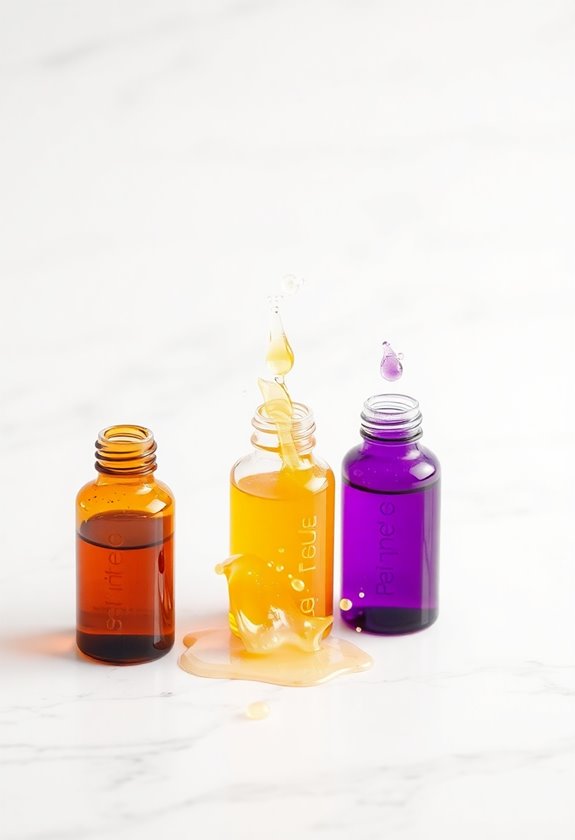
While layering serums can enhance your skincare routine, mixing them incorrectly can diminish their effectiveness or cause adverse reactions. You'll want to be particularly mindful of these common mistakes that can interfere with your skincare goals and potentially damage your skin barrier.
Here are the most critical mixing mistakes to avoid:
- Combining vitamin C with retinol, which can lead to oxidation and reduce the effectiveness of both ingredients
- Using multiple acid-based serums together, potentially causing irritation and over-exfoliation
- Mixing niacinamide with vitamin C without allowing proper absorption time between applications
- Applying oil-based serums before water-based ones, which prevents proper penetration of ingredients
Always check product ingredients carefully and wait 2-3 minutes between applying different serums to facilitate ideal absorption and effectiveness.
Wait Times Between Applications
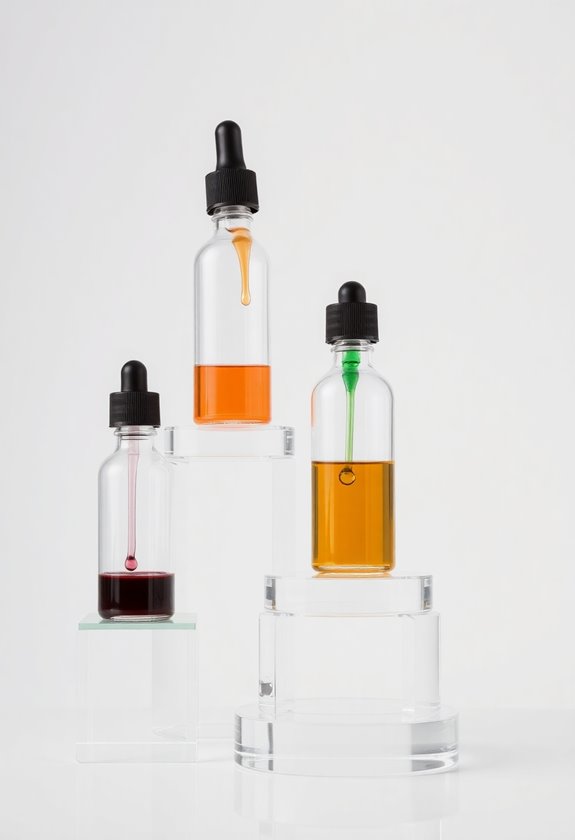
Proper wait times between serum applications can make or break your skincare routine's effectiveness. You'll need to give each product enough time to penetrate your skin before moving on to the next layer.
- Wait 30-60 seconds between water-based serums to allow each formula to absorb properly into your skin.
- Give peptide and niacinamide serums about 2 minutes to settle before applying your next product.
- Allow vitamin C serums 3-5 minutes to fully penetrate and stabilize on your skin's surface.
- For retinol-based products, you'll want to wait at least 5 minutes before layering anything else on top.
If you're pressed for time, gently pat your face to help each serum absorb more quickly while maintaining its effectiveness.
Ingredients That Work Together
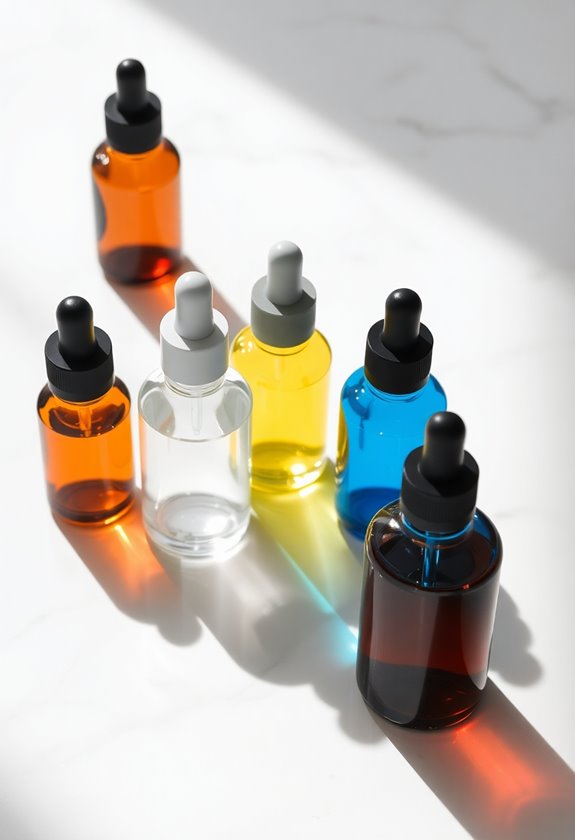
Understanding which skincare ingredients complement each other can maximize your routine's effectiveness and prevent adverse reactions. When you're layering multiple serums, certain ingredient combinations work particularly well together to enhance your skincare goals.
Some of the most effective ingredient pairings include:
- Vitamin C with Vitamin E and Ferulic Acid, which create a powerful antioxidant combination that enhances photoprotection
- Niacinamide with Hyaluronic Acid, working together to improve hydration and strengthen the skin barrier
- Peptides with Retinol, combining to boost collagen production and reduce visible signs of aging
- AHA/BHA with Ceramides, allowing for gentle exfoliation while maintaining proper moisture levels
You'll want to avoid mixing vitamin C with retinol or direct acids, as these combinations can cause irritation or reduce effectiveness.
Signs of Incorrect Layering

Sometimes layering your serums incorrectly can trigger visible warning signs that your skincare routine isn't working as intended. You'll notice these issues within minutes to hours after application:
- Your products start pilling or forming tiny balls on your skin, which indicates incompatible formulations or improper absorption
- Your face feels uncomfortably tight or sticky, suggesting you've applied products in the wrong order or used too much
- Your skin appears patchy or uneven, with some areas looking more saturated than others, pointing to inconsistent product distribution
- Previously absorbed products start surfacing or becoming cloudy when you apply subsequent layers
- Your skin develops unusual redness or irritation shortly after application, signaling potential ingredient conflicts or oversaturation of active ingredients
When you spot these signs, it's time to reassess your layering technique and product compatibility.
Frequently Asked Questions
Can I Use Different Brands of Serums Together in My Skincare Routine?
Yes, you can combine serums from different brands as long as they're compatible regarding their active ingredients. You'll want to check the main ingredients to avoid mixing products that could react negatively together, such as vitamin C with retinol. Always patch test new combinations on a small area of skin first, and introduce new products gradually to see how your skin responds.
How Long Does an Opened Serum Typically Last Before It Expires?
Time is ticking, and so is your serum's lifespan! Most opened serums typically last between 3-12 months, depending on their formulation and storage conditions. You'll want to check the PAO (Period After Opening) symbol on your bottle, which looks like an open jar with a number indicating months. If your serum changes color, texture, or smell before that time, it's best to toss it and get a new one.
Should Serums Be Applied to Damp or Completely Dry Skin?
You'll get the best results by applying serums to slightly damp skin, ideally right after cleansing when your face is still a bit moist. When your skin is damp, it's more permeable and can better absorb the active ingredients in your serums, making them more effective. However, if you're using oil-based serums, you should apply them to completely dry skin to guarantee proper absorption and prevent any barrier issues.
Can I Use the Same Serums During Pregnancy and Breastfeeding?
During pregnancy and breastfeeding, you'll need to modify your serum routine for safety. Common ingredients like retinol, salicylic acid, and high concentrations of vitamin C should be avoided during these periods. Instead, opt for pregnancy-safe serums containing ingredients like hyaluronic acid, niacinamide, and peptides. You should always consult your healthcare provider about specific products, as they can review your skincare routine and guarantee it's safe for you and your baby.
What's the Maximum Number of Serums I Should Use in One Routine?
You shouldn't use more than 3-4 serums in a single skincare routine to avoid overwhelming your skin and potential ingredient interactions. While it's tempting to try many products, layering too many serums can decrease their effectiveness and increase the risk of irritation. If you're using multiple serums, make sure they're targeting different concerns and contain compatible ingredients that work well together.

